ISSN ONLINE(2278-8875) PRINT (2320-3765)
ISSN ONLINE(2278-8875) PRINT (2320-3765)
Dr.Mohammad Haseeb Khan1, Dr. Arshia Azam2
|
| Related article at Pubmed, Scholar Google |
Visit for more related articles at International Journal of Advanced Research in Electrical, Electronics and Instrumentation Engineering
Sensorless controls of induction motor drives are widely used in industry due to their high performance. Of the various Sensorless control technique Model Reference adaptive system (MRAS) is the most widely used, in which PI controllers are conventionally used in the adaptation mechanism. The performance of many of the previously developed sensorless schemes for control of induction motor in low speed region is not found to be satisfactory. To improve the performance in the low speed region a novel method is proposed in this paper in which the conventionally used PI controller is replaced by an integrated fuzzy logic controller (IFLC) which is nothing but the combination of PI and fuzzy logic controller. Simulations are performed in Matlab/Simulink to verify the effectiveness of the proposed method. Simulation results are presented, analysed and compared for both PI and IFLC based MRAS speed observer and it is observed that the performance of motor during low speed region is improved with IFLC when compared to PI controller.
Keywords |
| Sensorless control, MRAS, PI controller, IFLC |
INTRODUCTION |
| Induction motors are widely used in high performance ac drives due to their low cost, ruggedness and reliable operation when compared to DC motors. Although induction motors have many advantages, they posses time-varying dynamic interactions and hence it is very difficult to design a high performance induction motor drive system using PI controller. Also when we are using speed sensors for speed measurement the reliability of the system decreases and hence the need for sensorless control of induction motor arises. With the use of sensorless control the cost and size of the drive are reduced there by increasing the reliability and robustness of the system with considerable reduction in maintenance requirement. |
| Of the various sensorless techniques discussed in literature, it is observed that these techniques have been applied successfully for high and medium speed operation [1, 2] but very low speed and zero speed operation still pose a problem. Amongst the different sensorless technique in literature MRAS is one of the most attractive techniques used due to their simplicity of design [3]. The different MRAS speed observers are usually based on rotor flux in which the rotor flux is used as the system error to identify the rotor speed [4-6], back EMF in which stator back EMF is used as the error to estimate the rotor speed [7,8]. The rotor flux MRAS speed observer was first proposed by Schauder [9] is the most popularly used scheme and lot of effort is being focused on this scheme for improving its performance. Majority of adaptation schemes used PI controller in the adaptation mechanism to generate the estimated motor speed. Conventionally used PI controller in the adaptation mechanism was replaced by a fuzzy logic controller in [11] and the performance of the induction motor was improved. To further improve the performance of the drive in the proposed method conventionally used PI controller is replaced by IFLC in the adaptation mechanism. Simulation results are presented to show the superior performance of the motor when PI is replaced by IFLC. |
MRAS SPEED OBSERVER FOR SENSORLESS CONTROL OF INDUCTION MOTOR |
| Schauder developed the conventional Model Referencing Adaptive System (MRAS) model which is shown in Fig.1. The MRAS speed observer uses two models namely adaptive model and reference model. The reference model is the one which is independent of the rotor speed and the adaptive model also known as adjustable model is dependent on the rotor speed. The outputs of these two models are compared and are used to form an error vector. The error hence obtained is minimized by using an adaptation mechanism. In the classical adaptation mechanism PI controllers are conventionally used to minimize the speed tuning signal and fed back to adaptive model. |
| The adaptive or adjustable or current model describes rotor equation and the rotor flux components are expressed in rotor speed and stator current. The adaptive model can be expressed in terms of the following equations [9, 10]. |
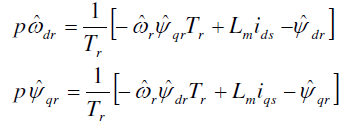 |
| The reference model or voltage model generates reference value of the rotor flux components in stationary reference frame from stator voltage and current components and these are obtained from the reference model as: [9, 10] |
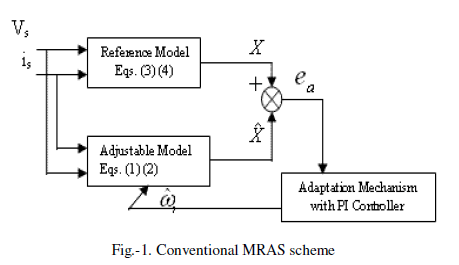 |
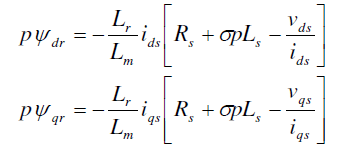 |
 |
| Finally the adaptation mechanism is obtained that generates the value of the estimated speed so as to minimize the error between the above two models which is fed back to the adaptive model. The estimated speed is given as |
 |
| Design and implementation of conventional control techniques using PI controller face difficulties such as: |
| (a) Drives are non linear systems and the control performance with this type of system decreases. |
| (b) Motor saturation or thermal variations do not cause expected performance. |
| (c) Variation of machine parameters by load disturbance. |
| So, designing a controller that has ability to adjust its own parameters and even structure online, according to the environment in which it works to yield satisfactory control performance is very much needed. This can be achieved by designing a fuzzy logic controller (FLC) which can robustly control in case of plant uncertainties and unknown external disturbances. FLCs employ a mode of approximate reasoning that resembles the decision making process of humans. The behaviour of a FLC is easily understood by a human expert, as knowledge is expressed by means of intuitive, linguistic rules. In the proposed method the conventionally used PI controller is replaced by IFLC which improves the performance of the drive is improved in low speed region considerably. |
IFLC BASED MRAS SPEED OBSERVER |
| The objective of this proposed method is to design a controller without exactly knowing the model which is not only simple but can also be easily implemented allowing good performance in terms of accuracy, overshoot and is fast under load and speed variations. The block diagram of proposed integrated fuzzy logic controller is shown in Fig. 2. In many cases, fuzzy control can be used to improve existing traditional controller systems by adding an extra layer of intelligence to the current control method. The different types of fuzzy controllers that are discussed in literature are basically multi input single output (MISO) type controllers [11-13]. The main preference of the fuzzy logic is that it is easy to implement control and it has the ability of generalization. |
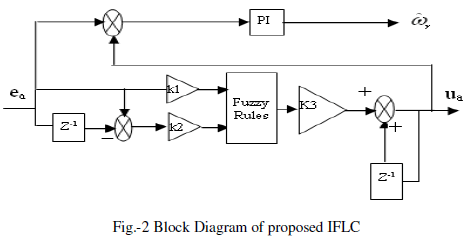 |
| The general block diagram of fuzzy controller is represented as shown in Fig. 3 and its structure is shown in Fig. 4. |
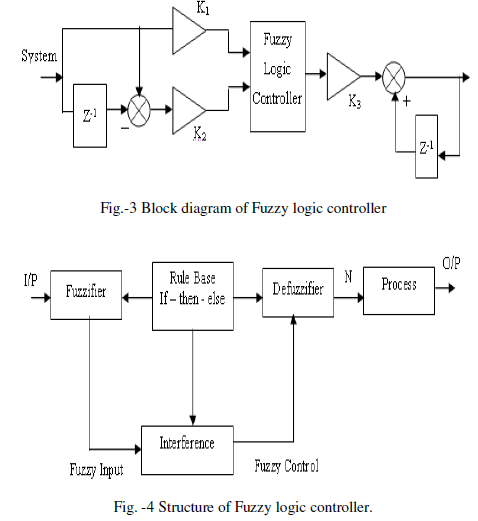 |
| The input is given to the fuzzifier where the fuzzyfication of the input takes. In the fuzzyfication component block scale mapping of input data and selection of fuzzyfication functions are to be considered. Scale mapping of data is nothing but converting the range of input variables which can be understood by the fuzzy logic controller where a specific range will be given. The fuzzyfication process converts the crisp data into fuzzy set. The rule base block actually holds the fuzzy rules which are applied to the given input. The decision making logic is present in the interference part which will make the decision as per the rules and logic present. Mostly the Mamdani’s method is used for decision making. It uses AND or minimum operator as fuzzy implication operator. |
| The number of inputs to the fuzzy controller can be 2 or 3. In the proposed method to reduce the complexity the two inputs are considered. The linguistics values that can be considered for each input are 3, 5, 7 or 9 as the case may be. Since there are two inputs, the numbers of rules that are possible are N X N or N2 which gives 9, 25, 49 or 81 rules for the above linguistic values respectively. As the number of rules increases in the rule base the computation time and the computation memory utilized will be high as the number of parameters involved in the approximation reasoning have increased. Hence the time taken for inference cycle becomes larger making its performance slower. The choice of linguistic value should be made keeping into consideration that the control should be good and computation taken by the fuzzy controller should not be high make the process slow. The linguistic value 3 which gives 9 rules is too small to get the better control. Controller with 7 or 9 linguistic values with 49 or 81 rules has large number of rules making the inference cycle slower. In this proposed method linguistic value of 5 is chosen which gives 25 rules. For fuzzyfication triangular fuzzyfication is used and for deffuzzyfication the centroid deffuzzyfication method is used in the proposed method. |
| Speed tuning signal ea and its rate of change ea are the inputs to the proposed FLC. K1 and K2 are the two scaling factors multiplied to the above inputs respectively. The output of the controller is then multiplied by a third scaling factor K3 and a discrete integration is performed to get estimated speed. The scaling factors should be chosen carefully after doing trial and error technique to get the optimal performance of the controller as they affect the performance of the fuzzy controller [11]. The values obtained for K1, K2 and K3 after trial and error technique are 0.05, 2 and 5 respectively. The command signals are ea and ea and the output of the fuzzy controller ua is given as: |
| The first step in designing the fuzzy controller is to generate the fuzzy rules based on the knowledge of the expert. According to the expert, three situations can be distinguished for the motor speed, namely, above, around and below the desired reference speed. By defining the system error between the measured speed and the desired speed, the propositions, higher, around and beneath the desired reference speeds are otherwise expressed as Positive, Zero and Negative errors. |
| The architecture of the proposed integrated fuzzy logic controller (IFLC) based MRAS speed observer for Sensorless control of induction motor is shown in Fig. 5 |
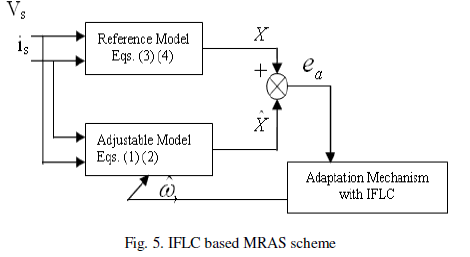 |
| In the present study Mamdani’s Max-Min rule base is used to formulate the control rules which use if-then rules. The trial and error method is used to tune the gains to get the best performance. In the proposed method 7 linguistic states have been considered which are NL=Negative Large, NM=Negative Medium, NS=Negative Small, ZE=Zero, PS=Positive Small, PM=Positive Medium, PL=Positive Large. The centroid deffuzification method is used to get the desired rules. The fuzzy control rules that are used for the proposed method are given in table I which has 49 rules [14,15]. The rules in the table are obtained using if – then – else rules conditions. |
| For example If ea is PS and Δea is NL then the output is NM |
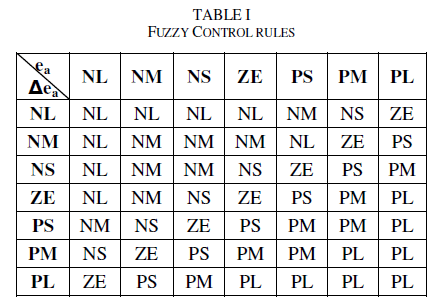 |
SIMULATION RESULTS AND DISCUSSION |
| The simulations of the both conventional PI & IFLC based MRAS speed observer for induction motor drive, as given in the appendix, are performed in MATLAB/SIMULINK. Fig. 6 and 7 shows the speed of the induction motor and electromagnetic toque during low speed regions i.e. 100 rpm on no-load with PI controller. For the same case of 100 rpm and no-load the speed and electromagnetic torque are shown in fig. 8 and 9. As can be observed the ripples in the torque and speed are minimized to a large extent. The response of the motor at 100 rpm and the electromagnetic torque with a load of 10 N-m applied at 0.5 sec with PI controller are shown in fig. 10 and 11 while the response with IFLC are shown in fig. 12 and 13 for the same condition. It can be observed that the effect of load torque variations is less making the induction motor robust to external load torque disturbances when IFLC are used along with the reduced ripples. |
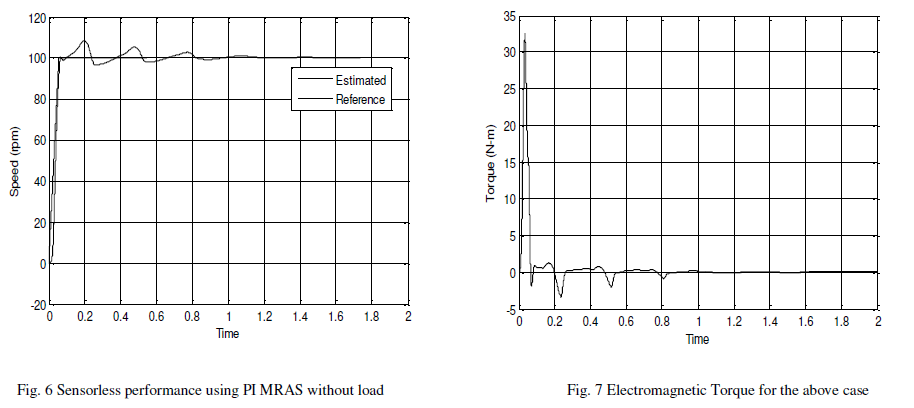 |
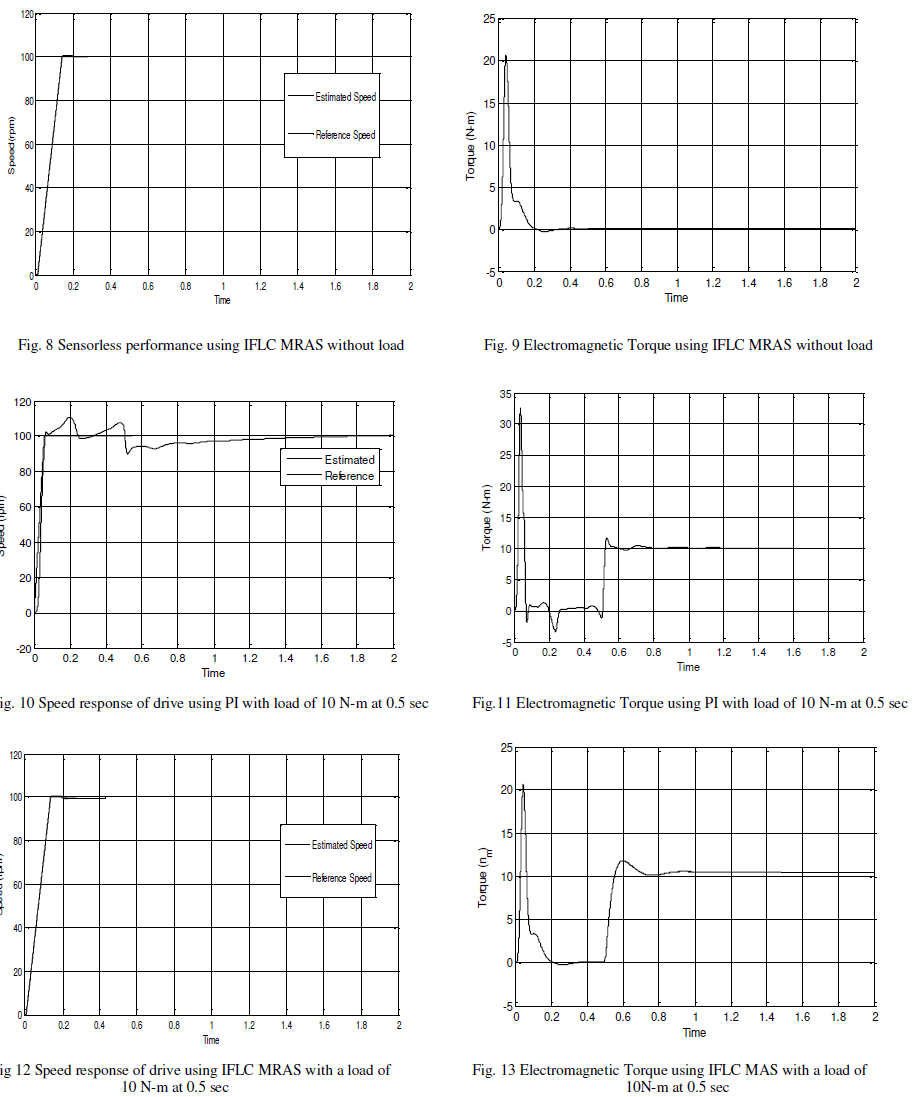 |
CONCLUSION |
| In this paper a novel adaptation mechanism using IFLC, which replaces conventionally used PI controller in the adaptation mechanism of the MRAS based speed observer for the sensorless control of induction motor is proposed. The speed estimation of motor using PI controller deteriorates at low speeds and hence proposed an IFLC based speed observer that not only improves the performance during low speed but also makes the motor robust to external load torque disturbances. The main advantage of fuzzy control is that when the reference speed changes the control parameters need not to be changed but this is not the case with conventional PI controller. Simulations are performed after tuning the parameters of both the schemes so as to obtain the best performance in each scheme. Application of IFLC shows better transient performance when compared to normally used PI controller. Also as can be seen from the different speed waveforms the speed error between the reference speed and estimated esteemed is low when IFLC is used in place of PI controller. |
APPENDIX |
| Induction Motor Parameters: |
| Rr = 3.55 Ω, Rs = 4.15 Ω, Ls = 0.76 H, Lr = 0.76 H, Lm = 0.646, J = 0.33 Kg.m2, No. of Poles =2 |
References |
|